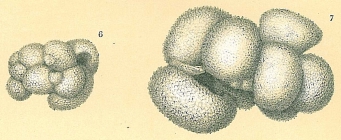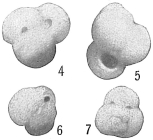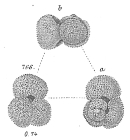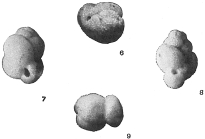
| Introduction | | Search taxa | | Taxon tree | | Taxon match | | Checklist | | Literature | | Stats | | Photogallery | | OBIS Vocab | | Log in |
Foraminifera taxon detailsGlobigerinoides Cushman, 1927
112199 (urn:lsid:marinespecies.org:taxname:112199)
accepted
Genus
Globigerina rubra d'Orbigny, 1839 accepted as Globigerinoides rubra (d'Orbigny, 1839) accepted as Globigerinoides ruber (d'Orbigny, 1839) (type by original designation)
Alloglobigerinoides Huang, 1986 · unaccepted (Opinion of Brummer and Kucera (2022))
Globicuniculus Saito & Thompson, 1976 † · unaccepted (Subjective junior synonym in...)
Subjective junior synonym in opinion of Mikrotax http://mikrotax.org/pforams/ Globigerinanus Ouda, 1978 † · unaccepted (Subjective junior synonym in...)
Subjective junior synonym in opinion of Spezzaferri et al. (2018)
marine,
recent + fossil
Cushman, J. A. (1927). An outline of a re-classification of the Foraminifera. <em>Contributions from the Cushman Laboratory for Foraminiferal Research.</em> 3(1): 1-105., available online at https://cushmanfoundation.allenpress.com/Portals/_default/files/pubarchive/cclfr/3cclfr1.pdf
page(s): p. 87; note: Type species Globigerinoides rubra. [details] Available for editors
Diagnosis Test with globular to ovate rapidly enlarging discrete chambers in a low to high trochospiral coil, few chambers per whorl,...
Diagnosis Test with globular to ovate rapidly enlarging discrete chambers in a low to high trochospiral coil, few chambers per whorl, sutures radial, depressed, umbilicus open, periphery rounded, peripheral outline lobulate; wall calcareous, coarsely perforate and spinose, pores at the base of shallow pits, the smooth spines circular in section and set on slightly raised spine bases; primary aperture a large interiomarginal umbilical arch, one or more secondary sutural openings present on the spiral side at the intersection of the spiral and radial sutures. Uppermost Oligocene to Holocene; cosmopolitan. (Loeblich & Tappan, 1987, Foraminiferal Genera and Their Classification) [details] Grammatical gender ICZN article 30.1.4.4. stipulates: "A compound genus-group name ending in the suffix -ites, -oides, -ides, -odes, or...
Grammatical gender ICZN article 30.1.4.4. stipulates: "A compound genus-group name ending in the suffix -ites, -oides, -ides, -odes, or -istes is to be treated as masculine unless its author, when establishing the name, stated that it had another gender or treated it as such by combining it with an adjectival species-group name in another gender form." Cushman (1917) did not give any indication about the gender of Globigerinoides but quoted the type species as G. rubra. He seems to have constantly used Globigerinoides as a feminine genus in his publications. Authors describing new species and subspecies have variously considered Globigerinoides to be a feminine or a masculine genus. Nevertheless the recent publications give at a great majority the genus as masculine. Considering the confusion about the grammatical gender, the WoRMS editors are applying the general ICZN rule and consider Globigerinoides to be a masculine genus. [details]
Hayward, B.W.; Le Coze, F.; Vachard, D.; Gross, O. (2021). World Foraminifera Database. Globigerinoides Cushman, 1927. Accessed at: http://www.marinespecies.org/foraminifera/aphia.php?p=taxdetails&id=112199 on 2025-05-12
Date action by 2006-09-12 06:54:36Z changed Martinez, Olga
original description
Cushman, J. A. (1927). An outline of a re-classification of the Foraminifera. <em>Contributions from the Cushman Laboratory for Foraminiferal Research.</em> 3(1): 1-105., available online at https://cushmanfoundation.allenpress.com/Portals/_default/files/pubarchive/cclfr/3cclfr1.pdf
page(s): p. 87; note: Type species Globigerinoides rubra. [details] Available for editors original description (of Globicuniculus Saito & Thompson, 1976 †) Saito, T., P. R. Thompson, and D. Breger, 1976, Skeletal ultramicrostructure of some elongate chambered planktonic foraminifera and related species, in Y. Takayanagi, and T. Saito, eds., Progress in Micropaleontology. New York: The American Museum of Natural History, pp. 278-304. page(s): p. 287 [details] original description (of Alloglobigerinoides Huang, 1986) Huang, T. Y., 1986, Alloglobigerinoides, a new planktic foraminiferal genus, Petroleum Geology of Taiwan 22:93-102. page(s): p. 93 [details] Available for editors original description (of Globigerinanus Ouda, 1978 †) Ouda, K. (1978). Globigerinanus, a new genus of the Globigerinidae from the Miocene of Egypt. <em>Revista Española de Micropaleontología.</em> 10: 355-378., available online at https://www.researchgate.net/profile/Prof_Khaled_Ouda/publication/258021402/ page(s): p. 358 [details] Available for editors basis of record Gross, O. (2001). Foraminifera, <B><I>in</I></B>: Costello, M.J. <i>et al.</i> (Ed.) (2001). <i>European register of marine species: a check-list of the marine species in Europe and a bibliography of guides to their identification. Collection Patrimoines Naturels,</i> 50: pp. 60-75 (look up in IMIS) [details] additional source Neave, Sheffield Airey. (1939-1996). Nomenclator Zoologicus vol. 1-10 Online. <em>[Online Nomenclator Zoologicus at Checklistbank. Ubio link has gone].</em> , available online at https://www.checklistbank.org/dataset/126539/about [details] additional source Loeblich, A. R.; Tappan, H. (1987). Foraminiferal Genera and their Classification. Van Nostrand Reinhold Company, New York. 970pp., available online at https://books.google.pt/books?id=n_BqCQAAQBAJ [details] Available for editors ecology source Leles, S. G.; Mitra, A.; Flynn, K. J.; Stoecker, D. K.; Hansen, P. J.; Calbet, A.; McManus, G. B.; Sanders, R. W.; Caron, D. A.; Not, F.; Hallegraeff, G. M.; Pitta, P.; Raven, J. A.; Johnson, M. D.; Glibert, P. M.; Våge, S. (2017). Oceanic protists with different forms of acquired phototrophy display contrasting biogeographies and abundance. <em>Proceedings of the Royal Society B: Biological Sciences.</em> 284(1860): 20170664., available online at https://doi.org/10.1098/rspb.2017.0664 [details] Available for editors  Present Present  Inaccurate Inaccurate  Introduced: alien Introduced: alien  Containing type locality Containing type locality
From editor or global species database
Diagnosis Test with globular to ovate rapidly enlarging discrete chambers in a low to high trochospiral coil, few chambers per whorl, sutures radial, depressed, umbilicus open, periphery rounded, peripheral outline lobulate; wall calcareous, coarsely perforate and spinose, pores at the base of shallow pits, the smooth spines circular in section and set on slightly raised spine bases; primary aperture a large interiomarginal umbilical arch, one or more secondary sutural openings present on the spiral side at the intersection of the spiral and radial sutures. Uppermost Oligocene to Holocene; cosmopolitan. (Loeblich & Tappan, 1987, Foraminiferal Genera and Their Classification) [details]Grammatical gender ICZN article 30.1.4.4. stipulates: "A compound genus-group name ending in the suffix -ites, -oides, -ides, -odes, or -istes is to be treated as masculine unless its author, when establishing the name, stated that it had another gender or treated it as such by combining it with an adjectival species-group name in another gender form." Cushman (1917) did not give any indication about the gender of Globigerinoides but quoted the type species as G. rubra. He seems to have constantly used Globigerinoides as a feminine genus in his publications. Authors describing new species and subspecies have variously considered Globigerinoides to be a feminine or a masculine genus. Nevertheless the recent publications give at a great majority the genus as masculine. Considering the confusion about the grammatical gender, the WoRMS editors are applying the general ICZN rule and consider Globigerinoides to be a masculine genus. [details]
To Biological Information System for Marine Life (BISMaL)
To European Nucleotide Archive, ENA (Globigerinoides) To Genbank To Mikrotax (Alloglobigerinoides Huang 1986) (from synonym Alloglobigerinoides Huang, 1986) To Mikrotax (Globicuniculus Saito & Thompson, in Saito et al. 1976) (from synonym Globicuniculus Saito & Thompson, 1976 †) To Mikrotax (Globigerinanus Ouda 1978) (from synonym Globigerinanus Ouda, 1978 †) To Mikrotax (Globigerinoides Cushman 1927) To Mikrotax (Globigerinoides Cushman 1927, emend Spezzaferri et al. 2015) To ITIS From editor or global species database
Hosted externally, from synonym
|












